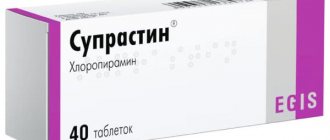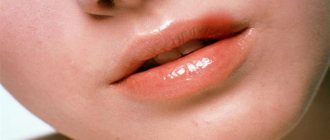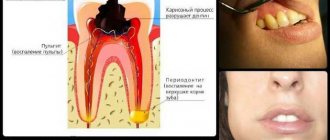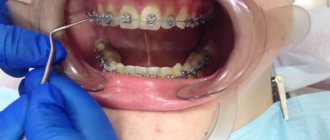Inflammation of the tonsils symptoms
The clinical picture depends on the form of the pathology. Acute tonsillitis is characterized by an abrupt onset with specific symptoms. Inflammation of the palatine tonsil has the following manifestations:
- fever (temperature reaches 39-40 degrees);
- severe cutting pain in the throat;
- discomfort when swallowing;
- soreness;
- lack of appetite;
- headache and joint pain;
- enlargement of nearby lymph nodes;
- malaise, weakness;
- nausea;
- drowsiness;
- swelling, redness of the tonsils;
- mucous or purulent plaque in the lacunae.
Sluggish tonsillitis is less severe, so patients often prefer not to treat it. Chronic tonsillitis - symptoms:
- low-grade fever (in the evenings, up to 37.5 degrees);
- bad breath;
- headache;
- sensation of a foreign body in the throat, soreness, burning;
- aches in joints and muscles;
- fast fatiguability;
- rashes on the face, body;
- aching pain in the lower back and kidney area;
- enlarged lymph nodes;
- sometimes - cough;
- insomnia;
- discomfort in the heart area;
- swelling and redness of the tonsils;
- nasal congestion, especially in the morning.
Why does my throat swell?
Swelling of the throat should not be confused with swelling of other organs of the neck, for example:
- swollen lymph nodes;
- external boils and abscesses;
- swelling of inflamed glands;
- chickenpox,
- piggy,
- mononucleosis;
- syphilis.
All these diseases lead to external swelling in the neck. You should always remember that laryngeal edema cannot be palpated. They manifest themselves in a series of signs that cannot be ignored. If your throat is swollen, you should immediately consult a doctor and determine the cause. The pathology is very dangerous. It can cost the patient his life. There are a number of factors that lead to swelling.
- Swelling of the respiratory tract is caused by allergens. Quincke's edema is associated with their entry into the body. The disease is deadly. In a matter of minutes, the tumor covers all tissues of the throat: palate, pharynx, tongue, oral cavity, larynx. As the swelling spreads to the lymph nodes, suffocation occurs.
- Laryngeal edema can develop due to foreign bodies. Fish bones stuck in the throat area, remains of solid food, small objects - all this can lead to swelling. This applies to a greater extent to children. But troubles happen to adults too.
- Swelling of the larynx is caused by diseases that are part of the viral group: scarlet fever, diphtheria, whooping cough.
- Sore throat can cause swelling in the throat area. The infection affects the tonsils. The disease is accompanied by:
- high temperature;
- swelling of the larynx;
- sore throat;
- hoarseness of voice.
Treatment is prescribed by a doctor. The causative agents of the disease are different bacteria. For proper treatment, the nature of the lesion must be established. A blood test will help with this.
Manifestations
Acute edema
If swelling is caused by inflammation of the tonsils, the patient experiences the following clinical picture:
- Temperature increase.
- The presence of chills, aggravated by a febrile state.
- The presence of a lump in the throat, as a result of which the patient experiences discomfort while eating.
- Development of pain.
- Manifestation of signs of intoxication - severe nausea, vomiting, dizziness.
During the examination of the pharynx, the doctor notes the presence of external changes: the patient’s tonsils are enlarged and covered with plaque. In addition to the tonsils, the inflammatory process affects the lymph nodes, as a result of which they swell and are easily felt during palpation.
Diet for sore throat
During the treatment of sore throat with swelling of the throat, you should follow a diet. Patients need to eat soft, pureed, slightly warmed food. They are forbidden to eat fatty, fried, salty and spicy foods. If you have tonsillitis, it is harmful to drink coffee, carbonated drinks, and alcoholic beverages.
Patients are in a state in which intoxication occurs. They need plenty of fluids to flush out pathogens. The drinking regime is observed using herbal teas, compotes and fruit drinks.
Features of treatment of the underlying disease
Since acute tonsillitis is caused in most cases by viruses, antibiotics are ineffective. Antibiotics can only help with bacterial inflammation of the tonsils.
The modern guide “Treatment of inflammatory diseases of the tonsils” presents two age-specific scoring systems. In addition to swollen tonsils, they also evaluate fever, cough, and swollen lymph nodes. Only above a certain score is an antibiotic recommended. Additional examinations - throat swabs - are intended only for rare individual cases.
If an antibiotic is prescribed, it is very important that it is taken as prescribed by the doctor (usually 5 to 10 days) because bacteria can persist in the body even after symptoms have disappeared for several days. Acute streptococcal infection ceases to be contagious approximately 24 hours after starting antibiotic therapy
Acute streptococcal infection ceases to be contagious approximately 24 hours after starting antibiotic therapy.
Analgesics - paracetamol or ibuprofen - help against associated symptoms: sore throat, headache and fever. Acetylsalicylic acid is not suitable due to its anticoagulant effect when tonsillectomy is imminent. A warm wrap or gargling with sage tea can help relieve symptoms and treat colds.
Not every severe tonsillitis requires surgery (tonsillectomy). The basis for the decision is the number of episodes of sore throat in the last 12 months.
For fewer than 3 episodes, the procedure is not recommended according to current guidelines. Tonsillectomy can be performed for 3 to 5 episodes and is a therapeutic option for 6 or more episodes.
For multiple recurrent tonsillitis, almond removal helps reduce symptoms. In particularly severe cases, surgery must be performed quickly. For moderate and mild forms, it is advisable to wait six months. Only if further inflammation occurs during this waiting period, despite repeated antibiotic therapy, is almond removal the best course of action.
Partial removal, called tonsillotomy, is a new option recommended in guidelines for the first time. Effectiveness has been proven in Swedish studies among children, adolescents and young adults. Tonsillotomy is much less stressful for patients.
If the doctor finds a peritonsillar abscess, drainage and antibiotic therapy will be performed. If the procedures do not help get rid of the abscess, it will be necessary to remove the tonsils at the so-called “hot” stage.
Rinse for laryngitis
Rinsing for laryngitis will help relieve pain from inflammation of the laryngeal mucosa, as well as relieve swelling and destroy pathogens. This can be done with medications purchased at a pharmacy, or you can turn to traditional medicine.
The most effective method is a mixture of equal amounts of St. John's wort, eucalyptus, calendula and chamomile per liter of water. An equally effective composition for rinsing is a decoction of black elderberry flowers, coltsfoot leaves, golden mustache, mixed in a glass of boiling water (1 teaspoon of each). The infusions are kept for about three hours, and rinses are carried out every hour.
Laryngitis is treated with apple cider vinegar. For this, 3 tbsp. vinegar is diluted in a liter of water and added to the composition 2 tbsp. honey It is recommended to gargle at least four times a day.
It is good to rinse with beet, lemon, carrot juice, sea buckthorn oil, propolis tincture, marshmallow or strong tea. Using old, candied honey when gargling can cause the mucous membranes to dry out.
The main condition for rinsing with laryngitis is that the water should be warm, not hot!
Prevention
If, after a sore throat, your throat periodically hurts again, it is necessary to take preventive measures. Laryngeal edema and complications will not arise if you follow the following recommendations:
- consult a doctor if tonsillitis occurs;
- strictly follow the treatment plan drawn up by the doctor;
- strengthen immunity;
- follow a diet;
- treat chronic infections in the nasopharynx (dental diseases, sinusitis, rhinitis, stomatitis).
With proper medical care, swelling of the throat, phlegmon, sore throat or other purulent infection goes away without consequences. Patients who follow the doctor’s advice quickly recover.
I write articles in various areas that, to one degree or another, affect such a disease as edema.
source
Causes of inflammation
Lymph nodes are part of the immune system. They destroy harmful microbes. When pathogens enter the body, the lymph intensifies the production of leukocytes - substances that kill infectious agents.
Nodes with a sore throat become excessively enlarged, and there is a feeling that the throat is sore. With weak immunity, the disease often recurs, as if the oropharynx just hurt, and again the whole palate is inflamed.
The development of throat edema is provoked by the following reasons:
- hypothermia;
- chronic diseases (ARVI, acute respiratory infections, colds);
- dental diseases;
- slow infections (pyogenic inflammations, gynecological pathologies);
- weak immunity;
- heavily chilled food;
- thyroid diseases;
- diphtheria;
- scarlet fever.
The main cause of swelling of the larynx is tonsillitis. All pathogens are neutralized by the tonsils. Enlarged lymph nodes indicate that defense mechanisms are fighting infection.
Methods for relieving soft tissue swelling
Let's look at how to relieve throat swelling with sore throat using home remedies.
You can carry out the following procedures yourself:
- Gargling with solutions of medications or infusions of medicinal herbs.
- Inhalations - using home remedies or using modern devices.
- Application of time-tested folk methods.
Rinse
When treating a sore throat at home, it is recommended to rinse at intervals of 1-2 hours with warm herbal decoctions - calendula, chamomile, sage. They relieve inflammation, making the patient feel better.
Classic gargles for sore throat are Furacilin, Rivanol (Ethacridine lactate), Chlorhexidine, Eludril, Rotocan, they have an antiseptic and anti-edematous effect. A 3% solution of hydrogen peroxide works well - before use, dilute a tablespoon of peroxide with half a glass of water; the resulting foam penetrates the lacunae of the tonsils, washing away pus and relieving inflammation.
The pharmacy chain offers a wide variety of inhalation products for sore throat
Inhalations
To relieve swelling and ease breathing, inhalations 5-6 times a day are recommended:
- with isotonic 0.9% solution (saline);
- with the addition of essential oils (sea buckthorn, eucalyptus, milk thistle, rose hips);
- with anti-inflammatory infusions of herbs (sage, chamomile).
- in case of severe edema - with hormonal components (Pulmicort).
There are many options for inhalation treatment. You can always figure out how to relieve swelling of the tonsils with a sore throat using products from your home medicine cabinet.
Inhalations using a nebulizer
Modern nebulizer devices facilitate the safe, fine spraying of medicinal substances on the inflamed mucous membrane of the throat. The instructions for the device warn that essential oils and herbal decoctions are not suitable for use.
But through a nebulizer you can spray saline or mineral water, as well as Pulmicort and mucolytic (a drug that reduces the amount of mucus) Lazolvan.
Rules for using sprays for throat swelling
Anti-inflammatory and antiseptic sprays Miramistin, Ingalipt, Hexoral, Lugol can alleviate the patient's condition.
When using the spray, you must follow the rules:
- First, you need to gargle with warm water to wash away mucus from your tonsils and throat.
- Rinse the removable nozzle with hot water.
- Hold the breath.
- Insert the nozzle into the mouth and press the valve, turning it first towards one tonsil, and then towards the other.
- Rinse the nozzle again with hot water.
- You must refrain from swallowing saliva for several minutes so that the medicine can have its therapeutic effect.
- Within 40 minutes after treating the throat, you should refrain from drinking and eating.
In the photo there is a children's nebulizer - the game perfectly distracts the child from the procedure
Use of sprays in young children
Sprays are not recommended for children under 5 years of age due to the risk of reflex laryngospasm. Only a doctor can prescribe them.
- They can be used only in those children who can comply with the request to inhale, exhale, hold their breath, and spit.
- Do not use the spray if you are allergic to its components.
- The spray should not contain alcohol.
- For one-year-old children with a sore throat, the spray is applied to the cheek or pacifier.
- Obstructive bronchitis is a contraindication for the use of the spray in a child.
When treating a sore throat, complex treatment is required, in which an important place is given to relieving throat swelling
Folk remedies
Gargling with folk remedies also helps fight swelling of the throat:
- Beetroot solution - 1 teaspoon of beetroot juice in half a glass of warm water;
- Carrot juice diluted in half with warm water;
- A solution consisting of 0.5 teaspoon of salt, a pinch of soda and 1 drop of iodine in a glass of warm water.
What to do with laryngitis?
Treatment of laryngitis requires the patient to follow simple rules - keep his feet warm, avoid hypothermia and stay in a draft.
To preserve your voice, it is necessary not to talk in the cold air and not to overstrain your vocal cords. What to do with laryngitis? It is important to monitor the cleanliness of the room where the patient is. The room must be cleared of dust. Undoubtedly, moderate temperature and air humidity will alleviate the condition. You should stop smoking, drinking alcohol and avoid spicy, hard foods.
Drinking plenty of warm solutions - tea or milk with honey, herbal infusions - will help relieve irritation of the laryngeal mucosa. An effective remedy for laryngitis is inhalation over steam or a special nebulizer device.
Relief from dry cough occurs after applying mustard plaster to the neck, chest and heels. It is also effective to take foot baths with mustard before bed. A proven method remains gargling and warm compresses on the throat.
Most often, treatment for laryngitis is complex, combining physiotherapy and medications. For a speedy recovery, it is better to visit a doctor who will give the necessary recommendations for treatment.
How to relieve throat swelling
Depending on the etiology of throat swelling, there are various methods to alleviate the condition. The insidiousness of this condition lies in the need to provide emergency assistance to save lives.
There are a lot of medications and improvised means, the use of which reduces swelling and inflammation:
| Pathology | Basics of therapy |
| ARVI, cold | Using infusions of sage, yarrow, chamomile, calendula, St. John's wort for gargling. Using inhallipt, cameton, oracept in the form of a spray for mouth irrigation. |
| Angina | Strict bed rest. Gargling with baking soda and table salt, herbal infusions, carrot or beet juice. Spraying the mouth with an antiseptic solution of chlorophyllipt and using it in oil form for rinsing. Taking dissolving pills. |
| Allergy | Swelling is controlled with antihistamines. When an insect bites, apply a tourniquet above the bite and use tablets or injections of diphenhydramine, or suprastin, or prednisolone. Adrenaline hydrochloride is used to irrigate the throat. At the same time, cold wet compresses should be applied to the throat. In extreme cases, artificial ventilation may be necessary. |
| Laryngitis | A characteristic feature of this pathology is the rapid development of swelling of the throat mucosa, requiring immediate first aid before the ambulance arrives. To do this, the patient is seated, the buttons on his clothes are unbuttoned, and warm milk or Borjomi is given to him to drink. The limbs are immersed in a container of hot water, and to relieve swelling, it is recommended to inhale, preferably with baking soda. In the room where the patient is located, it is necessary to increase the air humidity. |
| Pharyngitis | First of all, factors that irritate the mucous membrane of the throat are excluded. The throat is gargled with solutions of baking soda or furatsilin. Chlorophyllipt or ingalipt are used to irrigate the throat. Inhalations are carried out with anti-inflammatory and decongestant herbal decoctions or with alkaline mineral water. It is recommended to take absorbable antimicrobial pills, and, if indicated, antihistamines. |
| Injury | You should try as quickly as possible to get rid of the foreign body in the throat that causes its damage. To do this, you need to stand behind the victim. Having clasped his torso with your arms on both sides, you should press firmly with your fists in the area slightly above the navel. |
| GERD | Taking antacids or flight pump inhibitors (pantoprazole, lamprazole), and also drinking hot milk with soda. Sea buckthorn and rosehip oils will help reduce symptoms. |
Swelling of the posterior wall of the larynx
Swelling of the back of the throat is accompanied by certain symptoms:
- pain when swallowing, manifested in the back of the throat;
- difficulty turning the head;
- decreased voice timbre due to swelling of the vocal cords;
- tickling and dry cough;
- sensation of the presence of a foreign body in the larynx.
Upon visual examination, the posterior wall of the larynx appears granular, reddened and swollen. Based on these signs, it is difficult to determine the nature of the pathogen. Only a doctor can make an accurate diagnosis based on additional studies: laryngoscopy and bronchoscopy. If there is swelling of the posterior wall of the larynx, you should immediately consult a doctor. An inflammatory process that persists for several days can lead to more serious pathology.
The signs of swelling of the posterior wall of the larynx are interconnected: one follows from the other. Invaded into the mucous membrane, the infection causes inflammation. The inflammatory process leads to redness and swelling. The spreading infection invades more and more areas, reaching the vocal cords. The inflamed ligaments thicken, causing aphonia. The swollen mucous membrane narrows the lumen of the esophagus. This leads to difficulty and pain when swallowing.
Spreading inflammation affects the condition of the adjacent lymph nodes, which leads to pain when turning the head. A swollen larynx will not allow air to pass freely, creating shortness of breath. Poor oxygen saturation of the body leads to general malaise and pale skin.
With swelling of the back of the throat caused by an allergy, these symptoms include tearing and itching in the throat, nose and ears. With physical and emotional stress, shortness of breath appears. In extreme cases, hypoxia, respiratory arrhythmia, and convulsions may occur. The main difference between an infectious cause of throat swelling and an allergic one is the side symptoms. If swelling is accompanied by itching, then it is an allergy.
The causes of throat swelling are not always obvious. In most cases, they are associated with sore throats and allergies. But swelling can result from:
- Retropharyngeal abscess is the formation of a boil on the back wall of the larynx.
- Gastroesophageal reflux disease is a pathology in which the contents of the stomach return to the throat, and the acids it contains irritate the back wall.
- Throat injury caused by foreign bodies.
- Candidiasis. This fungal infection sometimes affects the tissues of the larynx.
Causes of throat swelling
About 60% of cases of swelling of the larynx occur as a result of mechanical injury to the mucous membrane of the throat, which can occur as a result of unsuccessful surgery, X-ray examination of the cervical spine, or prolonged bronchoscopy.
Sometimes swelling develops when eating certain foods or taking medications. This type of edema is called angioedema. In children, angioedema may occur after treatment with iodine preparations (Lugol), so their use is not recommended until the age of five.
Infectious diseases are another cause of inflammatory edema of the larynx. This symptom especially often accompanies purulent and lacunar tonsillitis. The formation of pus on the surface of the tonsils, palate, and root of the tongue causes damage to the surrounding mucous tissues, which quickly become inflamed and increase in size. Chronic infectious diseases (tuberculosis or syphilis) are sometimes accompanied by swelling of the vocal cords (a hoarseness appears in the voice).
Among the causes of non-inflammatory edema, doctors name the following:
- heart defects and other congenital pathologies of the cardiovascular system;
- kidney dysfunction;
- liver diseases (cirrhosis, hepatitis);
- compression of cervical vessels;
- allergy.
Causes of the disease
The pathogenesis of laryngitis includes:
- Viruses, bacteria. Diseases of the larynx, tracheitis, which are viral in nature, serve as a source of infection. In this case, laryngitis is a complication of colds.
- Environmental factors. These are allergens, dust, food. Children with diathesis are susceptible to frequent laryngitis.
- Physical features. Tendency to swelling of the laryngeal mucosa, loose texture of the nasopharynx tissue.
- Stress. Laryngitis can be a consequence of nervous shock.
- Reaction to medications. Sprays for the nose and throat can cause spasms of the ligaments and an attack of laryngitis.
- Hypothermia.
- Load on the vocal cords.
- Avitaminosis.
- Dry and warm indoor air.
- Poor oral hygiene.
- Chronic diseases of internal organs.
Folk remedies
Although opinions differ about the ability of folk remedies to help the body cope with a sore throat, many believe that “chemical-free” treatment can increase the body’s resistance to the following diseases. And often folk remedies help relieve swelling of the larynx.
Beet juice and calendula have an antiseptic effect from nature's pantry. These products are good rinsing aids. To prepare a rinse solution, add 1 teaspoon of one of these products to half a glass of water. It is necessary to rinse with this solution at least five times a day.
Salt, soda and iodine will help relieve pain during a sore throat. To prepare a rinse solution, add half a teaspoon of salt and soda to hot water. Add 4 drops of iodine, mix everything, wait for it to cool and use for rinsing.
Carrot juice has an anti-inflammatory and anti-edematous effect. It should also be used as a rinse solution. Add the same amount of carrot juice to half a glass of boiling water and rinse as often as possible.
You can also use carrot juice with garlic. To do this, add crushed garlic cloves (2 pieces) to a glass of juice and drink once a day before meals, 40 minutes. Continue taking for 3 days.
You can relieve pain with a carrot-honey solution. Take 1 part each of honey and freshly squeezed carrot juice and mix. Dilute the mixture with warm boiled water. Do rinses.
Horseradish will help relieve swelling and soreness of the larynx. It is necessary to add water to the grated horseradish. Use for rinsing.
Chamomile also has antiseptic properties. It will help cope with even severe sore throat. To do this, you should prepare the following infusion: pour 20 grams of vegetable oil into 0.5 liters of water, dilute with chamomile infusion. Use as a rinse.
You can use apple cider vinegar as a gargle for a sore throat. It will help relieve swelling of the larynx.
Among pharmaceutical preparations, Chlorophyllipt helps well. It helps fight staphylococcal infections that cause sore throat. This 1% alcohol preparation must be used for three rinses. Nowadays, this drug can be found in aerosol form. Treatment with this drug must be continued for at least 5 days, but do not forget that any drug can cause allergies.
In any case, at the first manifestations of the disease, it is best to consult a doctor. He will prescribe correct and effective treatment and identify the cause of the disease. And you shouldn’t start a sore throat until purulent sacs appear. After all, few people would want to go under the knife instead of undergoing treatment with pills and even injections. And in advanced cases, surgery is the only way out to achieve complete healing.
Swelling in the throat always signals that there are serious problems in the body. The occurrence of edema indicates health problems. Therefore, it is better not to self-medicate; you should consult a doctor to have your body examined.
In early and late stages
In pregnant women, laryngitis manifests itself quite quickly and often develops into a more complex disease: laryngotracheitis, bronchitis. This is due to a general weakening of the immune system. In this case, the use of effective drugs is prohibited.
In the later stages of pregnancy, local treatment is recommended, and potent drugs are prescribed for severe cases of the disease and in cases where the lack of treatment threatens complications. The choice of drugs in later stages is somewhat wider.
The use of drugs containing dextromethorphan is not allowed.
If possible, choose local treatment:
- inhalations - with Ambrobene, Rotokan, Furacilin. In this form, the drug acts on the source of inflammation and does not enter the systemic bloodstream;
- Irrigation of the throat and gargling - provide hydration and rapid removal of sputum;
- spastic severe cough is removed with the help of antitussives: Akodin, Ferfex. They have no toxic effects and can be used during pregnancy.
We invite you to familiarize yourself with Throat infections - symptoms and list of infectious throat diseases 2019
How to treat if a child has hoarse voice, you will find out in this article.
Symptoms of the disease
It is important for a doctor to distinguish acute tonsillitis, of any etiology, from diseases with similar symptoms. Depending on how the inflammation in the tonsils develops (mild or severe), signs of tonsillitis appear
In the acute form, the following symptoms develop at the beginning:
- high temperature appears, readings rise above 38 C;
- the patient’s condition is rapidly deteriorating - he develops fever, chills, unbearable pain in the oropharynx;
- a lump forms in the throat;
- when swallowing there is unbearable pain;
- swelling of the throat develops.
Examining the pharynx, the otolaryngologist notes the following manifestations:
- redness;
- swollen tonsils;
- purulent plugs in the pockets of the tonsils.
When palpating the neck, signs of edema are detected - swollen lymph nodes and tonsils.
With further development of sore throat, symptoms of intoxication arise:
- nausea and vomiting syndrome;
- headache.
Sore throat has a very serious impact on your health; you should not endure it on your feet. Delayed treatment leads to the development of life-threatening complications. Swollen tonsils block the windpipe, causing suffocation and Quincke's edema. A person dies if he is not given emergency assistance.
In chronic tonsillitis, the symptoms of the disease are slightly smoothed out:
- sore throat;
- weakness and fatigue appear;
- the patient regularly swallows saliva;
- lymph nodes are slightly enlarged;
- headache and muscle pain;
- breathing is difficult due to a lump in the throat.
Without treatment, tonsillitis becomes life-threatening and health-threatening.
How to treat laryngitis
To prevent the development of laryngospasm caused by severe edema, laryngitis must be treated as soon as the first symptoms appear. A doctor should prescribe therapy after conducting a complete diagnosis.
Pharmacy products
Treatment of laryngitis is carried out comprehensively, including the following groups of drugs:
- Antibiotics. They are used strictly according to indications, for laboratory-confirmed bacterial infection (Ceftriaxone, Augmentin, Ampicillin).
- Antihistamines. They relieve swelling and prevent its further development (Eden, Zodak, Suprastin).
- Anti-inflammatory. Reduce the activity of the inflammatory process, improve the regeneration of damaged tissues (Erespal, Inspiron).
- Antipyretic. They lower body temperature and improve overall well-being (Paracetamol, Eferalgan, Nurofen).
- Mucolytics. They thin sputum and improve drainage function (Ambroxol, Lazolvan).
In addition to these means, it is effective to carry out inhalations with a nebulizer with saline solution and mineral waters. With the permission of the doctor, if there is a tendency to laryngospasms, the hormonal drug Ventolin is administered by inhalation.
Folk remedies
Folk remedies in the fight against laryngitis are used only as adjuvant therapy to medications.
Good rinses for laryngitis. The following solutions are used for this procedure:
- soda-salt solution with added iodine;
- herbal decoctions;
- juices and tinctures of plants;
- apiproducts.
Drinking plenty of warm drinks with the addition of honey, lemon, and raspberries also helps in the treatment of laryngitis.
Steam inhalations will also be effective. To carry them out, decoctions of medicinal herbs, essential oils, and decoctions of root vegetables are used.
The easiest way for inhalation at home: boil the potatoes, cool slightly, add a spoonful of soda, cover with a towel, breathe in the steam for 10 minutes. This procedure for swelling of the larynx can only be performed with the permission of a doctor, so as not to harm the body.
Herbal decoctions.
Swelling of the throat in a child
Swelling of the throat in a child develops due to inflammation of the ENT organs and allergies. The severity of the disease is determined by the condition of the nasopharyngeal mucosa, the immune forces of the child’s body, and its response to pathology and medications.
With the development of swelling of the throat in children, the following is observed:
- Frequent, difficult breathing.
- Hoarseness of voice.
- Stiffness of the neck muscles.
- Soreness.
- Feeling of lack of oxygen.
- Pain in the neck area.
In children aged 1 to 7 years, one of the main reasons for the development of throat swelling is the narrowness of the respiratory tract.
Also, in children, the laryngeal mucosa is more prone to allergies and swelling, in which the lumen of the larynx becomes twice as small in size.
In pediatrics, there are a number of factors that directly indicate the development of throat swelling in a young child:
- Rapid pulse and irregular heartbeat.
- Change in skin color on the face and neck.
- The presence of watery rhinitis and conjunctivitis.
- Increased sweating.
- Listening to wheezing and coughing.
- Swelling of the nose, eyes, lips, tongue and area around the mouth.
- Manifestation of a metallic taste in the mouth.
- Dizziness and fainting.
- Psychoneurological signs: slurred speech, convulsions, increased excitability.
Principles of treatment
Swollen throat is not something to joke about. Acute tonsillitis should be treated by a doctor. First, an anamnesis is collected, a thorough examination is performed and the necessary treatment is prescribed.
If the sore throat is viral in nature, antiviral drugs and immunomodulators are prescribed.
If pathogenic bacteria have joined the inflammation, the patient is prescribed an antibiotic.
The acute phase of the disease excludes going to work or school. The patient's body needs a pastel regime, a special gentle diet, and plenty of warm drinks. Don't forget to ventilate the room 2-3 times a day. This will provide an influx of cool, fresh air and improve the patient’s well-being.
Give the patient not hot or cold food, but warm food. Fatty, fried, spicy foods should be excluded from the diet. Avoid alcoholic and carbonated drinks.
Symptomatic therapy is indicated. Antipyretic drugs if body temperature is above 38°C. Sprays and gargles to reduce inflammation.
Emergency help or what to do if your throat is swollen
Improper treatment of sore throat leads to a more severe course of the disease. The throat is swollen. This condition threatens with the following manifestations:
- it becomes more difficult for the patient to breathe;
- heart rate increases;
- pain in the neck increases;
- threat of panic attack.
If you experience the symptoms described, do not waste time. Do not panic. Follow the checklist.
- Dial the ambulance number.
- While waiting for doctors, stay close to the patient.
- Give the patient a sedative and antihistamine.
- Help me sit down.
- Apply something cold to your neck.
When the emergency doctor arrives, do not refuse hospitalization. Further treatment must be continued in a hospital setting.
How to relieve throat swelling with a sore throat at home
It must be remembered that during a sore throat, the tonsils are a breeding ground for germs. Therefore, you should constantly gargle after eating.
1.
Swelling of the tonsils can be treated with a decoction of chamomile or sage.
2.
Hard foods are contraindicated for people prone to edema.
3.
To relieve swelling of the throat, it is useful to gargle only with warm water. Do not use cold water as this may aggravate the situation. When rinsing, you need to tilt your head back and put as much medicine into your mouth as possible, and pronounce the sound “aaaa”
It is also important to rinse the nose, this will increase the activity of pathogens during local treatment
4.
Beet juice works well to relieve swelling of the tonsils.
5.
Known in the treatment of edema for its antiseptic properties, calendula is also known. To relieve swelling of the throat, you need to dilute one teaspoon in 1/2 glass of water, and gargle with this solution, if necessary, five times a day.
6.
Salt and iodine are effective against swelling. They should be dissolved in hot water along with salt, take ½ teaspoon of salt, soda, and the same amount of iodine up to four drops, mix, and apply this solution.
7.
Carrot juice will help relieve throat swelling. Dilute carrot juice with half a glass of boiling water. Treatment of swelling of the tonsils with this rinse is used five times a day.
8.
Horseradish juice is used when a patient has swelling of the tonsils. Dilute the grated horseradish with water and rinse, you can also separate the pulp from the juice.
9.
The antiseptic properties of chamomile are known; it helps with severe sore throat. The recipe is as follows: 20 g of vegetable oil per half liter of water, and add a decoction of dried chamomile flowers.
10.
Apple cider vinegar is also effective in relieving throat swelling.
11.
The pharmaceutical drug Chlorophyllipt fights staphylococcal infections and relieves swelling of the tonsils. This pharmaceutical preparation, in the form of a one percent alcohol solution, can be gargled three times a day. Today, the pharmaceutical drug Chlorophyllipt is produced in the form of aerosols. This is for those who cannot sit at home even when they have a sore throat. Treatment of swelling of the tonsils with Chlorophyllipt is carried out for at least five days
It is important to know that Chlorophyllipt may cause allergies in some people, so you should be very careful when using this drug
How to prevent throat swelling with sore throat
To prevent swelling:
1.
Strengthen your immunity.
2.
Temper yourself, play sports, do the legendary morning exercises.
3.
To prevent throat swelling, eat more vitamins, in particular fresh fruits and vegetables, and establish a nutritious diet.
4.
Take care of the hygiene of both the oral cavity and tonsils.
5.
Remember that healthy sleep is just as important as proper wakefulness; lack of sleep can be the main reason for weakening the immune system, since the body is being restored during sleep. The consequence of lack of sleep is increased irritability, and an increased amount of stress has a detrimental effect on our health, up to the appearance of such a phenomenon as swelling of the throat.
Sore throat (acute tonsillitis) is an infectious disease that is very easy to contract through contact with an infected person. The causative agents of the disease are viruses, bacteria, fungi, which begin their pathogenic activity under certain conditions. Conditions that contribute to the development of pathology include: hypothermia, swimming in cold water, prolonged exposure to air conditioning, eating cold foods or drinks. Children and adults with chronic diseases and weakened immune systems are most susceptible to sore throat. If acute tonsillitis is treated promptly and correctly, the person will fully recover without negative consequences. But without proper treatment, serious complications can develop during and after the illness, one of which is swelling of the throat due to sore throat. What to do in this case and how to cure this condition?
Treatment with antibiotics
Treatment for laryngitis is usually successfully carried out with medications. Before using them, of course, it is better to consult a doctor. Antibiotics for laryngitis are designed to relieve swelling and prevent the further spread of germs. Along with these medications, drugs aimed at reducing cough, especially non-productive ones, as well as relieving laryngeal swelling and allergies, help cure and relieve some symptoms of the disease.
Bioparox is very convenient for use. It is produced in the form of an aerosol, so it will not be difficult to give it to children who, as you know, do not like to take pills.
Most often, this is a concomitant disease, so broader-spectrum antibiotics may be prescribed for treatment of laryngitis.
By taking the prescribed course of medications, you can get rid of laryngitis at home, without having to stay in the hospital. But to cure this disease at home, you need to follow a regimen!
We invite you to familiarize yourself with Treatment of stomatitis on the lip, photographs
Medical assistance
An instrumental examination of the oropharynx (laryngoscopy) allows you to find out exactly where the inflammation occurred and what factors could have contributed to it.
A visual examination and study of test results helps the specialist determine the optimal course of therapy.
How to treat throat ligaments? After an accurate diagnosis, the doctor chooses one or more areas of therapy:
- steam inhalations;
- throat irrigation;
- ultraviolet irradiation;
- oral medication;
- electrophoresis with novocaine;
- surgery.
If the pathology is associated with inflammatory processes directly in the ligaments, it is best to seek help from a highly specialized specialist - a phoniatrist. He will prescribe adequate treatment for ENT diseases using drugs of symptomatic and etiotropic action.
General rules of therapy
How to restore the vocal cords of the throat and heal them quickly? The effectiveness of drug and physiotherapeutic treatment largely depends on compliance with the general rules of therapy. Large loads on the throat ligaments prevent tissue regeneration and restoration of their functionality. To speed up recovery, you need to:
- provide rest to the vocal folds - talking in a whisper prevents excessive stretching of the affected tissues, which promotes their epithelization;
- drink more fluids – drinking plenty of fluids speeds up the process of removing toxic substances from the body, which leads to increased local immunity;
- humidify the air - inhaling moist air allows you to eliminate dryness of the mucous membrane and accelerate the regression of catarrhal processes in the mucous membrane;
- perform inhalations - inhalation with solutions of anti-inflammatory and antiseptic action prevents the development of pathological processes and the synthesis of inflammatory mediators
- gargle - irrigating the oropharynx with decoctions of medicinal herbs accelerates the regeneration of the ciliated epithelium and, accordingly, the vocal cords.
Drug treatment of ENT diseases should be agreed upon with a specialist after the patient has undergone differential diagnosis. Catarrhal inflammation of the throat ligaments can be associated with the development of many ENT diseases, the treatment of which has significant differences.
The importance of timely help
Not all patients know how to properly relieve throat swelling with a sore throat. To eliminate tonsillitis, corticosteroid sprays are recommended, which, however, should be taken after consultation with a doctor.
There is no etiotropic treatment for tonsillitis because the disease is usually caused by a virus. For a bacterial infection, treatment is to take oral penicillin for a week.
Especially in the first years of life, during the so-called immunological phase of the body's learning, the tonsils play an important protective role. Previously, doctors recommended surgical removal of tonsils for tonsillitis. Tonsillectomy is rarely performed nowadays because the tonsil is an important part of the body's defense system.
In the first years of life, the tonsils begin to grow. After puberty, the volume and size of the tonsils decrease. In extreme cases, children's tonsils are sometimes so enlarged that they block breathing.










